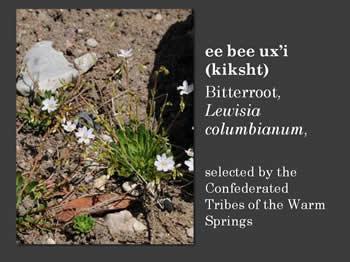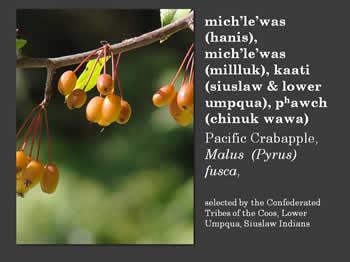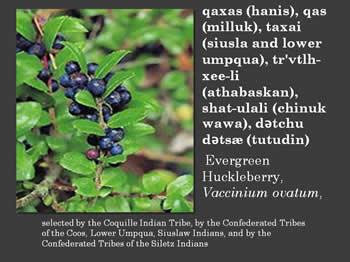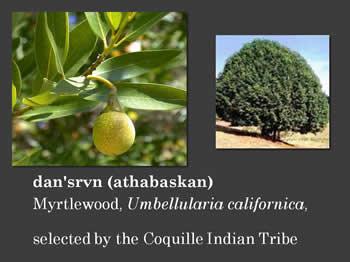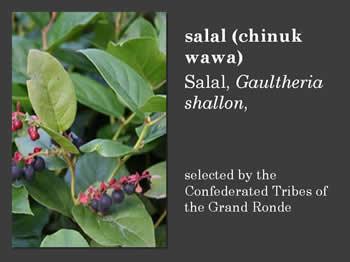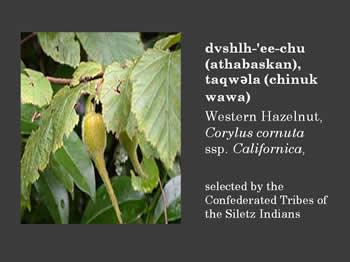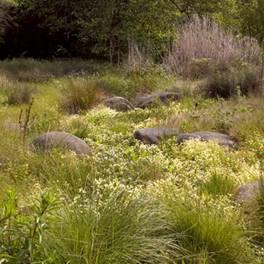Outside the Longhouse Building
The opening of the Native American Longhouse at Lane Community College honors Oregon's nine federally recognized tribes, both inside the building and in the landscaping outside and around it. The outside environment of the Longhouse provides three important honoring features.
A Pathway of the Tribes wanders through a camas/tarweed meadow past a swale. It honors the progress and sovereignty of the tribes and symbolizes the unity among our peoples. The swale honors our connection with the natural world by allowing the rain which falls on the Longhouse's footprint to soak in and recharge soil moisture, thus preserving the integrity of at least this small piece of Earth. Planted around the building are almost 100 species of plants that were important historically to Oregon's and other Native peoples, and many of them continue to be important today.
Pathway of the Tribes
We envisioned a pathway near the Longhouse through a plantation of native plants to honor Oregon's nine tribes. We asked that each tribe select one or two plants to represent that tribe in the plantings around the Longhouse. A total of twelve plants were selected for us. These twelve species of plants are named here. They are planted, however, in various spots around the Longhouse, allowing interested persons the opportunity to appreciate the plantings by searching for them. One specimen of each of these species displays a label at its base that describes the species of plant and its uses. First, on each label appears the Native names. The Pathway of the Tribes meanders north from the salmon-cooking pit around the east end of the swale and then to the west, ending on the northwest side of the swale. A small meadow planted densely with camas lilies and with tarweed bisects the swale a short distance from its beginning point. Both camas and tarweed were intensively cultivated by fire by the Willamette Valley's Kalapuya Indians. In order to keep out weeds and too much grass, this meadow is covered with landscaping cloth during the winter. In early spring, the cover is removed to allow the camas bulbs to send up their lily-like leaves and blue flowers. Soon afterward, the tarweed seeds will sprout and produce a beautiful green carpet before becoming dry and rangy by the fall.
Plant Species Selected by Oregon's Tribes
The Swale
The swale looks like a pond in winter, and a garden in summer. Rainwater draining from the Longhouse flows a short distance north to a depression that receives and stores the water and allows it to soak into the soil, cleansing the water and revitalizing the soil moisture. The swale will hold standing water during the rainy months, then continue to drain into the surrounding soil during the dry months. It is planted in a natural and artistic way with native plants that are or were used by Oregon's Native peoples. Wetland plants most tolerant to standing water are in the bottom of the swale, and plants less tolerant are arranged around its sides. In this way we maintain a sustainable stewardship of this small piece of our land.
Native Plantings
Nearly 100 plants that have been used by Oregon's Native peoples have been planted around the Longhouse to reflect nature and be appealing to the human eye. Please feel free to wander the grounds and admire these plants, many of which you will undoubtedly recognize or may even be familiar to you. At the same time, be respectful of these important parts of our culture and our heritage, and show respect for the work that went into preparing these grounds. Please consult the complete list of species below, organized in several categories.
Plants Requested by Oregon Tribes for Pathway of the Tribes:
- Bitterroot, Lewisia columbianum
- Myrtlewood, Umbellularia californica
- Salal, Gaultheria Shallon
- Bunchgrass (Idaho Fescue), Festuca idahoensis
- Pacific Crabapple, Malus (Pyrus) fusca
- Salmonberry, Rubus spectabilis
- Evergreen Huckleberry, Vaccinium ovatum
- Quaking Aspen, Populus tremuloides
- Western Hazelnut, Corylus cornuta ssp. californica
- Mountain Huckleberry, Vaccinium membranaceum
- Red Osier Dogwood, Cornus sericea
- Wokas (Yellow Pond-lily), Nuphar polysepalum
Plants with Important Uses by Native Peoples of Oregon:
- Camas, Common, Camassia quamash
- Camas, Great, Camassia leichtlinii
- Cattail, Typha latifolia
- Common Rush, Juncus effuses
- Harvest Lily, Dichelostemma congestum
- Kinnikinnick, Arctostaphylos uva-ursi
- Maple, Big Leaf Acer macrophyllum
- Oak, Oregon White, Quercus garryana
- Ocean Spray, Holodiscus discolor
- Serviceberry, Amelanchier alnifolia
- Sitka Spruce, Picea sitchensis
- Slough sedge, Carex obnupta
- Tarweed, Madia sativa
- Thimbleberry, Rubus parviflorus
- Wapato, Sagittaria latifolia
- Western Red Cedar, Thuja plicata
- White Fawn Lily, Erythronium oreganum
- Willow, Pacific, Salix lucida ssp. Lasiandra
- Yampah, Perideridia gairdneri
Additional Plants Used by Native Peoples of Oregon:
Trees & Shrubs:
- Alder, Red, Alder, Alnus rubra
- Ash, Oregon, Ash, Fraxinus latifolia
- Buckthorn, Califoria Coffeeberry, Rhamnus californica
- Buckthorn, Cascara, Buckthorn, Rhamnus purshiana
- Ceanothus, Buckbrush, Ceanothus cuneatus
- Ceanothus, Redstem, Ceanothus, Ceanothus sanguineus
- Ceanothus, Blueblossom, Ceanothus thrysifloris
- Cedar, Incense, Cedar, Calocedrus decurrens
- Chokecherry, Prunus virginiana
- Black Cottonwood, Black, Populus trichocarpa
- Creeping Snowberry, Symphoricarpos mollis
- Current, Flowering, Current, Ribes sanguineum
- Dogwood, Pacific, Dogwood, Cornus nutallii
- Douglas fir, Pseudotsuga menziesii, Douglas fir
- Elderberry, Red, Sambucus racemosa
- Elderberry, Blue, Sambucus caerulea
- Hawthorn, Oregon, Crataegus suksdorfii
- Hemlock, Western Hemlock, Tsuga heterophylla
- Huckleberry, red, Vaccinium parvifolium
- Madrone, Pacific, Arbutus menziesii
- Maple, Vine, Acer circinatum
- Mockorange, Philadelphus lewisii
- Tall Oregon Grape, tall Mahonia aquifolium
- Dull Oregon Grape, dull (Long Leaf), Mahonia nervosa
- Osoberry, Oemlaria cerasiformis
- Oregon Viburnum, Viburnum ellipticum
- Pacific Ninebark, Physocarpus capitatus
- Rose, Baldhip, Rosa gymnocarpa
- Sagebrush, dwarf, Artemisia arbuscula
- Sagebrush, big, Artemisia tridenta ssp. wyomingensis
- Twinberry, Lonicera involucrata
- Western (Pacific) Rhododendron, Rhododendron macrophyllum
- Western Azalea, Rhododendron occidentale
- Western Bog Laurel, Kalmia microphylla
- Western Rosebud, Cercis occidentalis
- Willow, Hooker's, Salix hookeriana
- Willow, Scouler's, Salix scouleriana
- Willow, sitka, Salix sitchensis
Perennials:
- Alum root, green-flower, Huechera chlorantha
- Alum root, roundleaf, Huechera cylindrical
- Alum root, Huechera grossulariafolia
- Baneberry, Actea rubra, baneberry
- Barestem lomatium, Lomatium nudicaule
- Bunchberry Dogwood, Cornus unalaschkensis
- Cow parsnip, Heracleum lanatujmm
- Flowering Current, Ribes sanguineum
- Fringecup, Tellima grandifolia
- Goatsbeard, Aruncus dioicus
- Lily, Columbia (Tiger), Lilium columbianum
- Lily, Leopard, Lilium pardalium
- Oregon avens, Geum macrophyllum
- Potentilla from Iron Mt, OR, Potentilla sp .#1
- Skunk cabbage, Lysichiton americanus
- Sulfur Buckwheat, Eriogonum umbelletum
- Sword Fern, Polystichum munitum
- Wild ginger, Asarum caudatum
- Wood Strawberry, Fragaria vesca
- Yarrow, Achillia millifolium
Wetland & Grasses
- Bulrush, Hard stemmed, Scirpus acutus
- Bulrush Small fruited, Scirpus microcarpus
- Scouring rush, Equisetum hymenale

